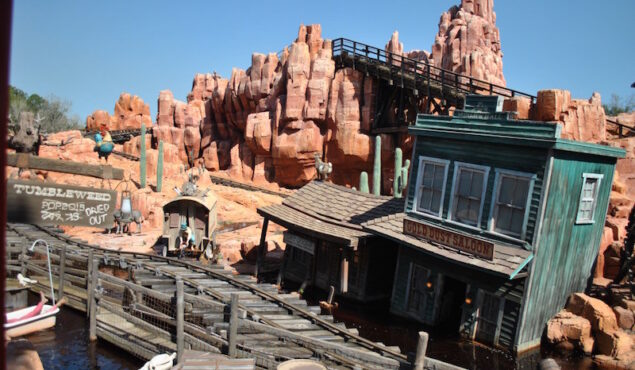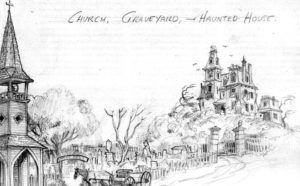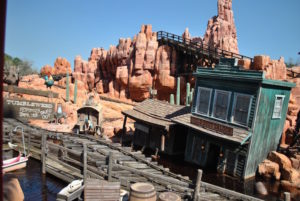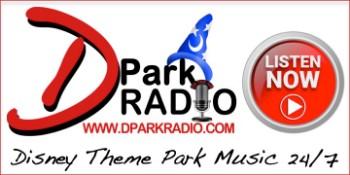
The Wildest Ride in the Wilderness
By Heather M. Leber
“If any of you folks are wearin’ hats or glasses, best remove ’em – ’cause this here is the wildest ride in the wilderness.”
– Big Thunder Mountain Railroad
A runaway train ride through an abandoned and cursed mining town, Big Thunder Mountain Railroad is a thrill ride for the Disney Adventure seeker. Known to be the “wildest ride in the wilderness,” guests board a train car and head out on just one of the experiences Walt Disney World has to offer. The ride’s history dates back to before Walt Disney himself had started looking at Florida for a theme park.
When Walt Disney first began looking for land to build a second theme park, he briefly looked at a plot of land outside of St. Louis, Missouri. This park was to be called “Walt Disney’s Riverfront Square.” When Walt Disney began considering this section of the country for his new park he tasked animator and Imagineer Marc Davis – who had an extensive attraction resume that included rides such as The Enchanted Tiki Room, The Haunted Mansion, and Pirates of the Caribbean – with the project of creating a showpiece ride for the new park. Davis accepted the job and started to develop a Lewis and Clark themed ride. The initial idea was to take guests on a boat ride through scenes of the Louisiana Purchase expedition.
As time went on Walt Disney chose to move the plans for the new park to Florida. Davis began to revise his original idea into what would be a heavily promoted project called Thunder Mesa. Davis had big plans for his new project, with hopes of it being the crowning masterpiece of his career. To quote author Christopher E. Smith, Davis “wanted to ‘out-pirate’ his signature Pirates of the Caribbean.”
In 1969 as Walt Disney World began taking shape, the corporation released a booklet on attractions for the new park. The booklet featured opening day attractions – showing the new rides that the company wanted to bring to the new world. Among the attractions listed were Space Mountain, Country Bear Band (later renamed Country Bear Jamboree) and Swiss Family Isle (later renamed Swiss Family Tree House). Among the listings was that of the new land Thunder Mesa featuring it’s main draw The Western River Expedition.
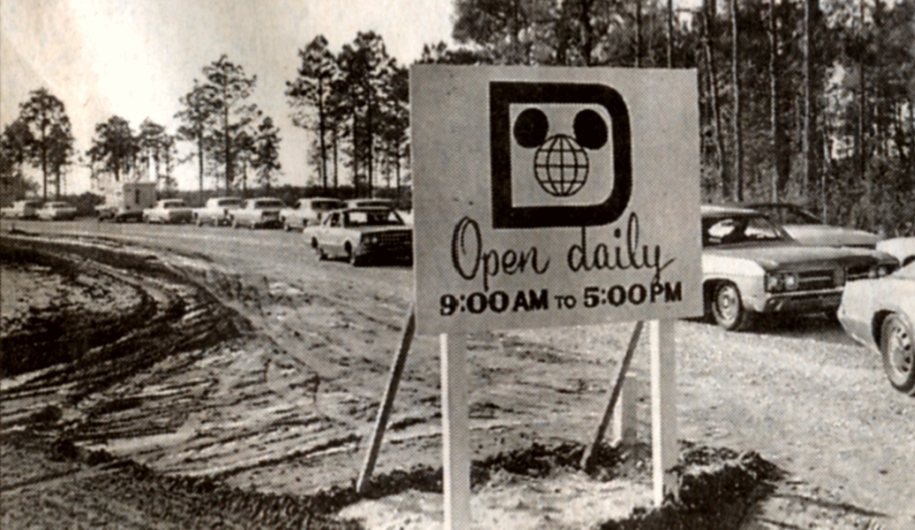
Thunder Mesa was to be it’s own area of the park and to house two separate attractions: a runaway mine train ride and The Western River Expedition being the revised Lewis and Clark ride. Davis felt the new revisions would allow the ride to fit in better with it’s home in Florida. Thunder Mesa was to be a large area of the park, sitting on the land that would become Splash Mountain, the Brier Patch Gift Shop and Big Thunder Mountain Railroad. The concept of The Western River Expedition was to take guests on a boat ride through a parody of the Old West ending with a drop much like Splash Mountain. The ride was to be built on the scale of Disneyland’s Pirates of the Caribbean. Davis had envisioned for this ride to be the main attraction of what would become Adventureland and Frontierland.
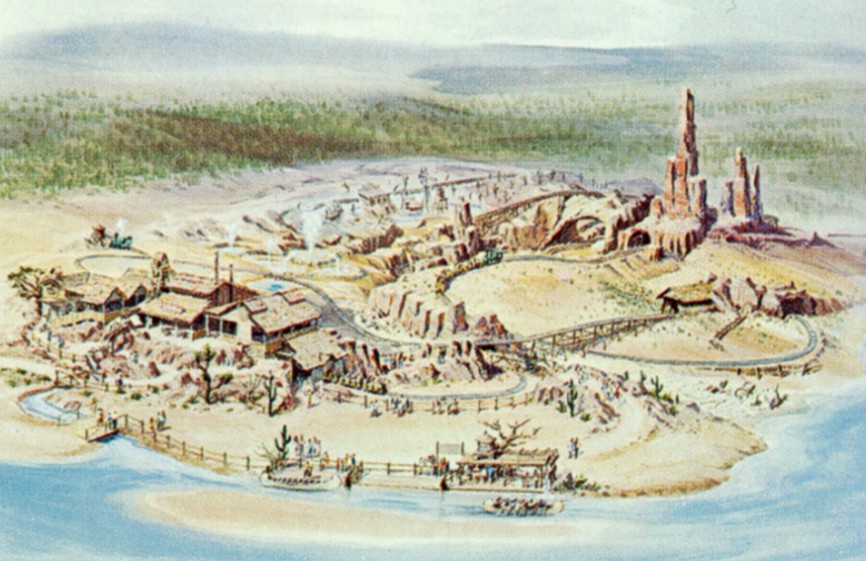
Originally to be part of Opening day attractions, Thunder Mesa’s fate began to be questioned as opening day neared and the price tag and ambition for the project grew. The Imagineers and executives were faced with a choice. Did they proceed with the expensive project of Thunder Mesa and force several opening day attractions onto the Phase 1 expansion list, or put Thunder Mesa on the Phase 1 expansion in order to devote resources to other opening day rides? The decision was made to move Thunder Mesa onto the Phase 1 expansion list. This decision was made due to the expected opening day numbers. In order to handle the crowds that were anticipated, Thunder Mesa which consisted of only two attractions was moved in order to open several attractions.
The issue of Pirates of the Caribbean not transitioning to Florida also added the the fate of Thunder Mesa. The executives in charge of building the world made the decision to leave Pirates of the Caribbean out was due to location. The executives felt that Florida’s close proximity to the actual Caribbean would lessen the excitement of the attraction. When Walt Disney World was being planned, the corporation thought of the park as an add on for many vacation goers. As stated in a memo written for the 1970 Annual Report, “Walt Disney World is by definition a destination point, a place where people will come from afar and where they will stay for several days in combination with a visit to Florida or the Caribbean area.” With that said, the executives felt people wouldn’t care about fake pirates being so close to where the real pirates sailed. On top of that, Pirates of the Caribbean was one of Disneyland’s most expensive attractions. With the cost of Walt Disney World growing, the leads on the project felt it wasn’t feasible to build a Florida version of the ride.

On October 1, 1971 when Walt Disney World opened its gates for the first time, park guests were not only appalled but many where angry at the lack of Pirates of the Caribbean. Guest Relations where fielding an overwhelming amount of complaints and angry phone calls from fans who had come expecting to see pirates. Many cast members were asked the question “where are the pirates?” The demand for a Florida version of Pirates of the Caribbean grew so much that then President of Walt Disney World, E. Cardon Walker decided the park needed it’s own version. Cast Members began wearing buttons saying “Pirates are coming, Christmas 1973.” Marc Davis was named head Imagineer of the new pirates project.
At first Davis tried to convince Walker to wait and to allow him to develop his plans for an even better boat ride. However, Walker was insistent that they develop a Pirates of the Caribbean for Florida and they develop one fast. Davis ultimately agreed to work on the project in hopes that Walker would continue to green light Thunder Mesa.
Plans moved forward to develop Pirates of the Caribbean. By Fall of 1972 the spot in Adventureland was chosen. The plot of land that was chosen was smaller than what Davis had to work with in California, forcing an abridged version of the ride Still, he held out hope that Thunder Mesa would come into existence. On December 15, 1973 Pirates of the Caribbean opened in the Magic Kingdom and has remained a fan favorite.
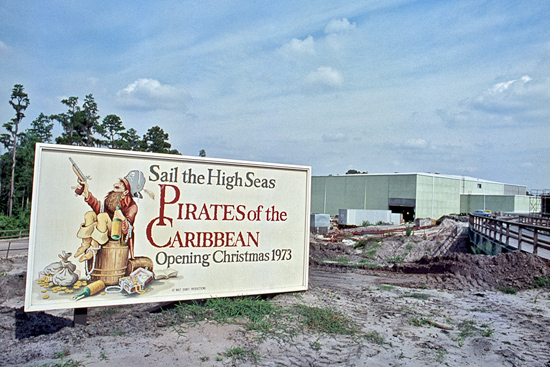
Roy O. Disney had been one of Thunder Mesa’s biggest supporters. With his death on December 20, 1971, Davis lost one of the driving executives for the project. On top of this, the land that would ultimately house Thunder Mesa sat next to where Pirates of the Caribbean was being built. Disney executives were concerned that two boat rides side by side would not be a good idea.
With the location being a possible hindrance, Thunder Mesa’s fate also dealt with a continually growing price tag. As the price began to climb, Walker began to look for cost cutting measures one of which was to use the molds that were made for Pirates of the Caribbean to be used for Thunder Mesa characters. Even though Davis wanted to see his vision through to completion he refused Walker’s suggestion of reusing molds. The final finical factor that played a role in canceling the project was the energy crisis of the 1970s. Many park goers were traveling to the park by car and with the rise in gas prices the American Tourist Industry (including Walt Disney World) saw a down turn in business.
Even with the finances in question, one of the final blows for Thunder Mesa when E. Cardon Walker was in one of the Imagineering studios. He saw a scale model for Thunder Mesa. Imagineer Tony Baxter had helped to build the model and was present on the day Cardon was in the workshop. Cardon gave Baxter some critiques on the model before offering him a position to develop a run away mine train ride – a project that would be separate from one the one Davis had been developing as part of Thunder Mesa. Baxter agreed and began working on Big Thunder Mountain Railway. The ride was green lit by Disney executives and a version was built for both Disneyland and Walt Disney World. Still, the development didn’t kill Thunder Mesa, initially. Promotional material for Big Thunder Mountain Railway included promotional material for Thunder Mesa. It still appeared that the project would be built. The model that Baxter helped build sat in the park featuring Hoot the Owl, the Western River Expedition narrator, to show guests what the project could be. By all indications of the promotional material, Big Thunder Mountain Railway was the first step into completing Davis’s ambitious project.
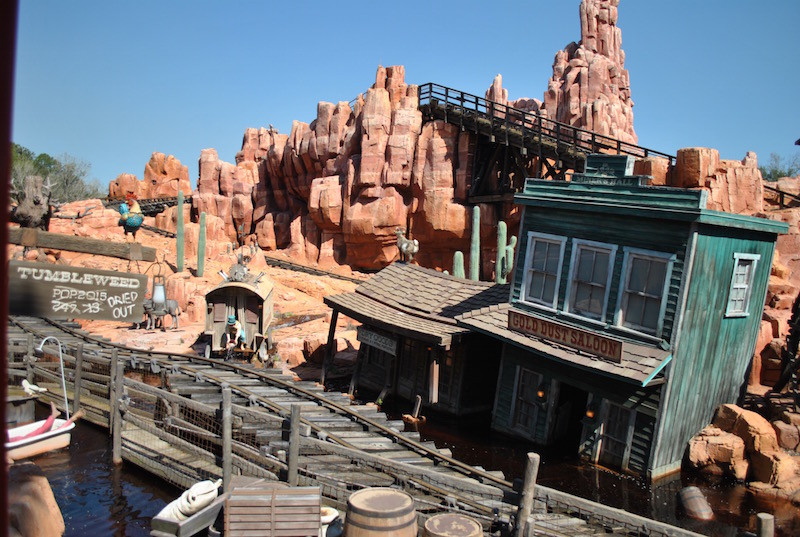
Unfortunately for Thunder Mesa, Big Thunder Mountain Railroad sat 200 feet high. The size of the project ended up making it the focal point for Frontierland. Many believe that once the executives saw the sheer size of the attraction that they felt this should be the centerpiece for the land making it the final blow to Davis’s masterpiece. Baxter had wanted to see Thunder Mesa constructed. He purposefully designed Big Thunder Mountain to accommodate the rest of Thunder Mesa to be built right next to it. By 1975 Disney announced that the Phase 1 expansion of the park had been completed. This didn’t bode well for Thunder Mesa coming into being since Phase 2 was to be dedicated to EPCOT. With the amount of development and promoting that went into Thunder Mesa, the project was quietly canceled. Unfortunately, Davis would never see his masterpiece to completion.
The project that Davis had set out to turn into reality would have changed the Magic Kingdom as we know it. Marc Davis is a part of Disney legend for many reasons and this project, had it been built, would have only added to his legend. If circumstances had gone in Davis’s favor, park goers would be enjoying a different Magic Kingdom today.
Photos@Disney and WDW Kingdom
Are you passionate about Disney? Do you want to be a contributing author to WDW Kingdom like Heather? Use the contact us button on the top of this page and reach out. We look forward to hearing from you!
(all articles and opinions in the articles are that of the author and may not reflect the opinion of WDW Kingdom)
